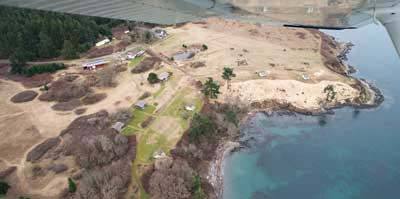Although the dust has yet to settle over the now-infamous waterfront clearcut at the former Mar Vista Resort, the property’s new owners are in pursuit of a dock.
Not just any dock, but a 271-footer (10 yards shy of the length of football field) that can accommodate up to six boats, 20-30 feet in length, and a stone’s throw from San Juan Island’s False Bay.
The owners, David and Nancy Honeywell, intend to develop a “family compound” with six homes on the 30-acre parcel by building a new residence and rehabilitating and remodeling some of the former resort cabins and caretaker house, according to Francine Shaw of the Friday Harbor-based Law Office of Stephanie O’Day.
Shaw, who is spearheading the dock proposal and other land-use issues on behalf of the Honeywells, said local regulations allow each of the those six waterfront homes access to a dock, but that the property may have to be sub-divided into separate parcels for the dock, and for the remodel and construction projects, to proceed.
“The county may require us to sub-divide, but that hasn’t been decided yet,” Shaw said. “That’s not necessarily what the Honeywells want to do, but we’re going to follow the path of least resistance.”
In response to the dock application, San Juan County’s Community Development and Planning Department determined the dock poses no significant adverse impact to the environment, issuing a Determination of Non-Significance (DNS) following its review of the State Environmental Policy Act. Deadline for comment on the SEPA determination is June 4; deadline for comment on the dock proposal is June 25. The proposal is slated to go before the county hearing examiner Aug. 11.
The dock would be located in a so-called “pocket beach,” roughly 50-100 feet beyond the University of Washington’s biological preserve at False Bay, Shaw said.
A proposal to build a “joint-use, community dock” is the latest eyebrow-raiser surrounding the new owners of the former westside resort, one of the larger contiguous waterfront properties on the westside of San Juan Island. New docks are rare on the island’s westside, seasonal home and feeding grounds of the Southern Resident killer whales, listed as endangered under federal law.
The Honeywells, formerly of Virginia and winners of a nine-figure Powerball jackpot in February 2013, purchased the property a little over a year ago for $6 million under an incorporated, Virginia-based entity known as Orca Dreams.
In early February, San Juan County issued a “notice of violation” after nearly two acres of waterfront at the Orca Dreams property were denuded of trees, shrubs and vegetation in late December without proper permits. The county subsequently fined David Honeywell $1,000 and fined Allen Engle of Solid Ground, whose contracting business oversaw removal of the vegetation, $2,000 for the violation; the fines have reportedly been paid.
The county, along with the state Department of Ecology, also required that a restoration plan be prepared for the denuded area of shoreline and submitted for approval of both agencies. That plan is still in the works, according to Bob Fritzen of Ecology, which sent Orca Dreams a warning of its own in the wake of the so-called waterfront clearcut, for violating the state Water Pollution Control Act.
The restoration plan’s due date has been pushed back until August by the county, Fritzen said.
“We were hoping they would’ve gotten more in already,” he said. “My understanding is that they said they needed more time to do it right.”
Fritzen said that DOE has made one of its biologist available to assist in development of the restoration plan. He also noted, following a recent site-visit to the Orca Dreams property, there are remnants of a prior dock at the proposed location of what would be the new one. Ecology tracks and catalogs dock permits but rarely weighs in on a proposal unless it requires a “variance” in local rules or “conditions” for approval are placed on it.
Shaw, who accompanied Fritzen on the site-visit, said those monitoring the denuded area have noted a 30 percent increase in the number of golden paintbrush plants since the previous vegetation was removed. Golden paintbrush is considered threatened by the U.S. Fish & Wildlife Service.
Shaw said that the dock’s design consists of materials that would allow about 70 percent of sunlight to pass through the structure to the seafloor below. It would be removed during winter months to protect it from exposure to the harsh weather, then reinstalled in late May and remain in place until late October, she said.
The application for the dock was submitted to the planning department March 28, several days before the update of the county critical areas ordinance went into effect.




